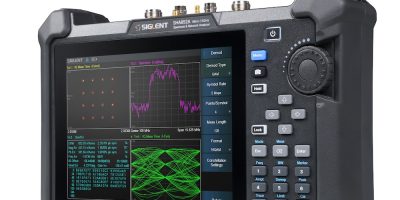Handheld spectrum and VNA address increase in field test demands
The first handheld spectrum and vector network analyser (VNA) by Siglent Technologies is the SHA850A series. It has been introduced to meet the increased demand for field test requirements in mobile communications and wireless connectivity, said the company. The explosion of related industries such as 5G and IoT has created an extremely complicated electronic measurement environment which is increasingly shifting from laboratories and workstations to onsite and outdoor applications, requiring handheld analytical and measurement instruments.
The SHA850A series handheld spectrum and vector network analyser has been added to the company’s RF and microwave portfolio. This new form factor is highly integrated and specifically designed for field operation. It is lightweight and portable with accurate measurements and flexible analysis capabilities and includes a battery pack and carry bag.
The SHA800A can handle advanced characterisation or signal capture applications in harsh working environments, confirmed Siglent.
In spectrum analyser mode it measure up to 7.5GHz. The DANL (displayed average noise level) is as low as -165dBm, which can effectively identify small signal levels. The single sideband phase noise is less than -104dBc per Hz at 1GHz with a 10kHz offset, comparable to a benchtop spectrum analyser. There is an optional independent full frequency source, which together with the standard 25dB pre-amplifier provides fast scanning speed and high sensitivity for a variety of applications. The measurable frequency range in vector network analyser mode and cable and antenna measurement mode is from 100kHz to 7.5GHz with a dynamic range as high as 114dB. This is critical for applications such as measuring the passband and out-of-band rejection performance of filters at the same time as well as measuring narrowband devices with high rejection.
The SHA800A series supports simultaneous measurement of amplitude and phase response, and simultaneous measurement of S11 and S21 parameters. Display echo / insertion loss, phase, group delay, standing wave ratio, Smith chart, polar chart, reflection / transmission co-efficient and other formats are included. The spectrum and VNA also supports distance to fault (DTF), time domain reflectometer (TDR), one-port cable loss, two-port insertion loss, return loss and VSWR measurement functions. Speed up transmission debugging and troubleshooting with modulation analysis options including ASK / FSK / PSK / MSK / QAM digital modulations and AM / FM / PM analogue modulations. Intuitive measurements of EVM and transmission quality factors as well as visualisation modes including eye diagrams and constellations extend troubleshooting to complex signals and systems. The standing wave ratio (SWR) of an antenna is an index indicating the matching degree between antenna and base station. The larger the standing wave ratio, the higher the reflected power and the lower the transmission efficiency, that is, impedance mismatch. Advanced time domain (TDR) analysis can accurately measure the characteristic impedance of transmission lines and help to locate the specific location of breakpoints or short circuits.
Distance to fault measurements can be made to locate the fault position of transmission line system components, which shows the magnitude of response signals at different positions along the signal path thus providing a basis for judging impedance changes that may affect performance.
Signals can be analysed on the 8.4-inch multi-touch display. Universal USB and LAN communication interfaces enable connections to a PC for remote control or for use with an external mouse and keyboard. The instrument has a rugged shell to protect it from impact or external shock damage.
The SHA850A series weighs only 3.2kg and is suitable for outdoor and handheld operation. The included rechargeable battery lasts up to four hours. The instrument can be equipped with GPS positioning and logging functions that will automatically tag measurements as they are made with GPS positioning during survey work.
The ANT-DA1 series handheld directional antenna has a frequency range of 10MHz to 8GHz and includes three directional antennas with different frequency bands and a handle with a built-in broadband low-noise amplifier and a rechargeable battery.




